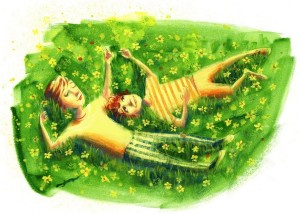“In the spring a young man’s fancy lightly turns to thoughts of love.” Alfred Lord Tennyson.
Welcome Springtime! For native born San Diegan’s like myself, have you experienced a colder or rainier season here than what we just had? I’m happy to put winter behind and bring in the new – flowers, warm weather, flip flops, baseball and … Spring fever.
Is it my imagination, or does spring fever really exist? Can love really be in the air? Helen Fischer, a neuroscientist, professor at Rutgers University and author of five books on the science of love says that love is a “motivation system”. It’s a drive which is part of the reward system of the brain. There are three key components of love, involving different but connected brain systems.
- Lust – (the sex drive or libido) driven by androgens and estrogens, the craving for sexual gratification
- Attraction – (early stage of intense romantic love) driven by high dopamine and norepinephrine levels and low serotonin, romantic or passionate love, characterized by euphoria when things are going well, terrible mood swings when they’re not, focused attention, obsessive thinking, and intense craving for the individual
- Attachment – (deep feelings of union with a long term partner) driven by the hormones oxytocin and vasopressin, the sense of calm, peace, and stability one feels with a long term partner.”
(The above components of love are also associated with the three stages in relationships.)
What does this have to do with Spring? Everything in nature seems to come alive with spring – flowers are in bloom, smells fill the air, the weather gets warmer, and people spend more time together outdoors. As the days get longer, melatonin in our body decreases (which gives us greater energy and vitality). Bulky clothing are replaced by skimpier lighter clothing which reveals a lot more curves and skin. All stimulating, new and novel experiences which release dopamine, the feel good hormone of the brain. Spring fever is alive and well.
I’m intrigued and grateful for the research on the science of love. We now know by studying the brain how to deliberately activate loving feelings and help couples restore closeness in long term relationships. Another hormone associated with increasing closeness is oxytocin, the cuddle hormone. Touching, hugging, holding hands and gazing into the eyes of another person, releases oxytocin. It has a powerful bonding effect for infants to adults. It breaks down social barriers and increases self-esteem, builds trust and reduces the effects of pain.
So touch often, spend time doing new things with loved ones and take advantage of the opportunities springtime provides.
Photo credit: travistysbeard.blogspot.com
Share this Blog



Found your internet site on Facebook, great post. Will share again.
This is a topic that’s close to my heart… Best wishes! Exactly where are your
contact details though?
Hello and thank you for your message. I’m surprised that you’re not able to contact me via my page so I’ve got my computer genius checking this out. My contact information, though is Carolyn@gerardCounseling.com, (858) 756-8171. I look forward to speaking with you.
I am sure this paragraph has touched all the internet visitors, its really
really nice post on building up new blog.